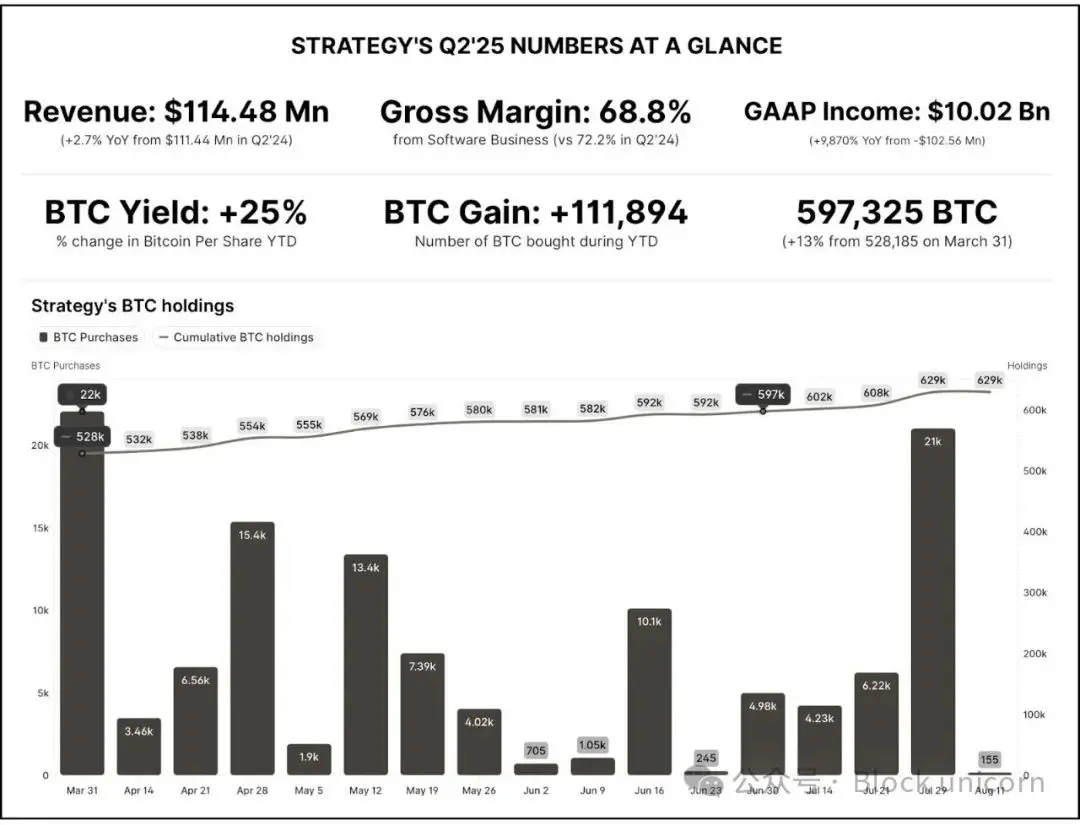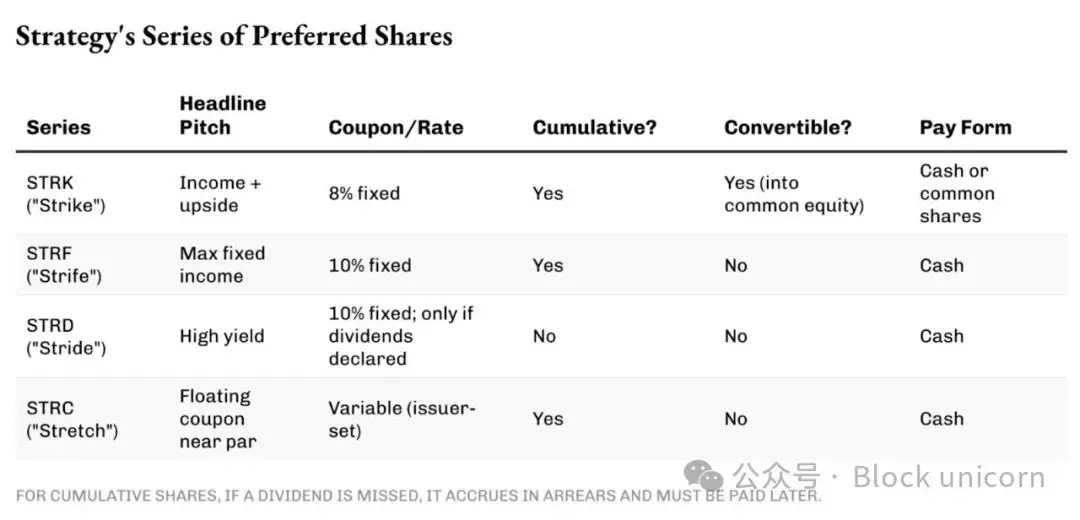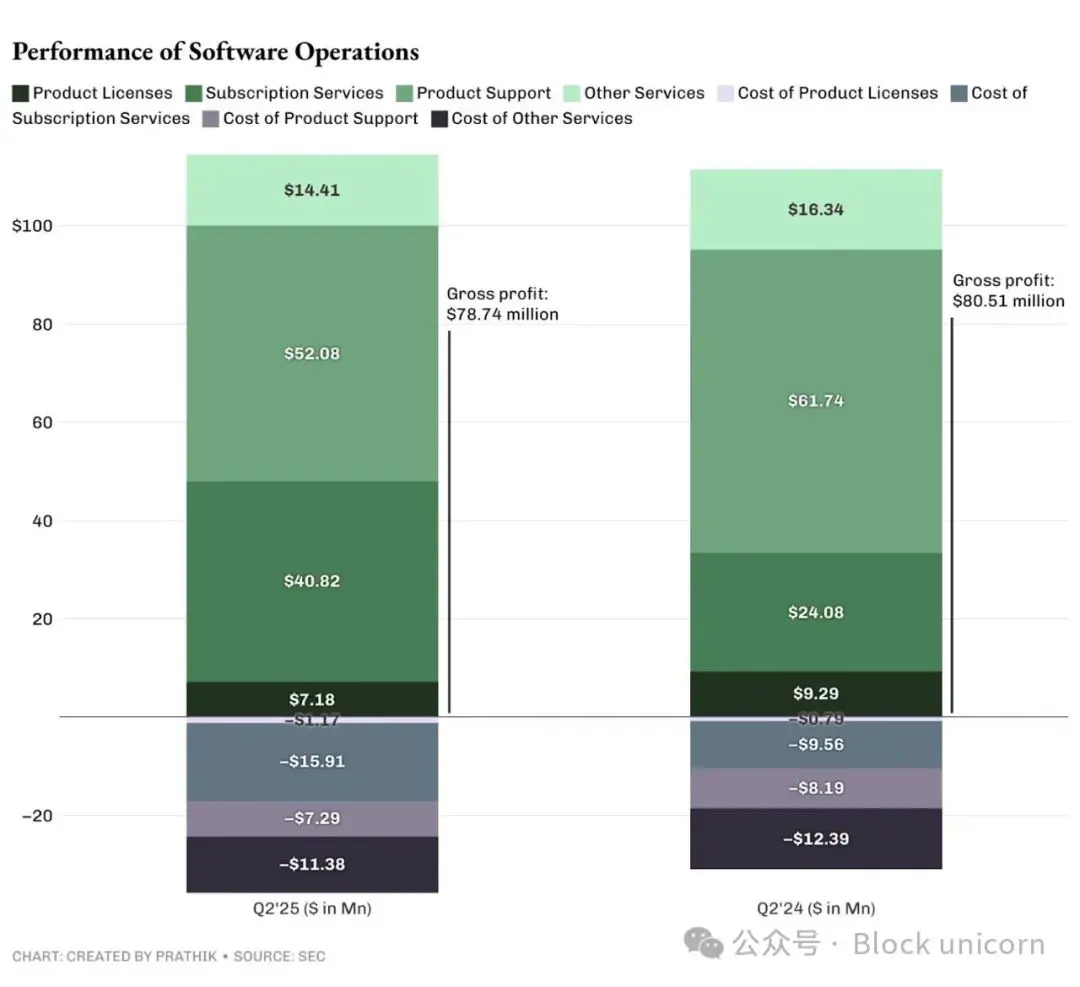Article Author: Prathik Desai
Article Translation: Block unicorn

Today, we delve into the financial report of Strategy Company (formerly MicroStrategy) for the second quarter of 2025, marking the first quarter in which the company achieved a net positive income after adopting fair value accounting for Bitcoin, creating one of the largest quarterly profits in the company's history.
Key Points
Strategy's Bitcoin treasury strategy generated $10 billion in net income (compared to a loss of $102.6 million in Q2 2024), driven entirely by $14 billion in unrealized Bitcoin gains under the new accounting standards.
The software business remained stable but took a back seat, with revenue of $114.5 million (a year-on-year increase of 2.7%), a narrowing profit margin, contributing approximately $32 million in underlying operating income.
Aggressive capital raising continued, with $6.8 billion raised in Q2 through equity and preferred stock issuance, expanding Bitcoin holdings to 597,325 BTC, accounting for 3% of the circulating supply, valued at approximately $64.4 billion.
After the financial report was released, Strategy's stock price fell by 8%, from $401 to $367; since then, the stock has rebounded to above $370.
The trading price of Strategy's stock is 60% higher than the net asset value of Bitcoin, meaning investors need to pay $1.60 for every $1 of Bitcoin held.
Main Argument: As long as Bitcoin prices continue to rise and capital markets remain open, Strategy's Bitcoin treasury strategy is effective, but it introduces significant earnings volatility and dilution risk, rendering traditional software metrics irrelevant. However, its early entry into the asset management field provides Strategy with ample buffer space to cope with a Bitcoin price crash.
Financial Performance: Bitcoin as the Key Driver
Strategy Analytics reported a net profit of $10.02 billion for Q2 2025, in accordance with U.S. Generally Accepted Accounting Principles (GAAP), contrasting sharply with a net loss of $102.6 million in the same period last year. Diluted earnings per share reached $32.60, compared to a loss of $0.57 in Q2 2024.
The year-on-year net income growth of 9,870% is almost entirely attributed to the $14 billion in unrealized Bitcoin gains recognized after the adoption of fair value accounting in January 2025. This marks a departure from the old accounting system, which required companies to assess their BTC holdings at cost minus impairment, where price increases could not be recognized on the books, while any price declines had to be accounted for as impairment losses.

The scale of this accounting impact becomes more apparent when compared to Strategy's operating business income. The total revenue for Strategy in Q2 was only $114.5 million, meaning the reported net profit margin exceeded 8,700%, a phenomenon entirely caused by the appreciation of cryptocurrency.
Excluding Bitcoin revaluation, the underlying operating income was approximately $32 million, with a healthy profit margin of about 28% for software revenue, but insignificant compared to the unexpected gains from cryptocurrency.
GAAP operating income reached $14.03 billion, a significant improvement from the $200 million operating loss in the same period last year (which included substantial Bitcoin impairment charges under the old accounting system).
Quarterly volatility was extreme. In Q1 2025, due to Bitcoin dropping to around $82,400 in March, GAAP net loss was $4.22 billion. With Bitcoin rebounding to $107,800 in June, the second quarter saw a profit of $10 billion, marking a quarter-on-quarter turnaround with earnings exceeding $14 billion.
Management acknowledged that fair value accounting makes earnings "extremely sensitive" to Bitcoin's market price. Strategy's profitability is currently primarily influenced by cryptocurrency market fluctuations rather than software sales.
Adjusted net income (excluding stock-based compensation and minor projects) was approximately $9.95 billion, compared to a negative $136 million the previous year, roughly in line with GAAP, as Bitcoin-related adjustments far exceeded traditional add-back adjustments.
Treasury Financing
As of June 30, 2025, Strategy held 597,325 Bitcoins, more than 2.5 times the 226,331 Bitcoins held a year ago. Currently, with additional purchases in Q3, the holdings have reached 628,946 BTC. The total cost basis is $46.094 billion (an average of $73,290 per BTC), while the market value is approximately $74.805 billion, with unrealized gains of about $29 billion—more than double that reported in Q2.
In Q2, Strategy acquired 69,140 BTC for approximately $6.8 billion, equivalent to the total amount raised by the company during the same period. The average purchase price in Q2 was about $98,000/BTC, indicating that the company steadily accumulated as prices climbed from the April lows. No Bitcoin sales occurred, adhering to its chairman Michael Saylor's "HODL" strategy, resulting in no realized gains.
The financing structure has evolved into a complex capital market operation:
Common Stock ATM Program: In Q2, approximately 14.23 million shares were issued, raising $5.2 billion, with an additional $1.1 billion raised in July. The program currently has about $17 billion in capacity.
Preferred Stock Series: The strategy innovated various perpetual preferred stocks to continuously raise funds for Bitcoin purchases in any market environment while limiting dilution of common stock. Different series offer varying yields and maturities, aligning financing costs with investor preferences at the time.

Convertible Bonds: In February, Strategy issued $2 billion in 0% convertible preferred bonds, maturing in 2030, with a conversion price of $433.43. Although these bonds do not provide interest, bondholders have the right to convert them into Strategy's Class A common stock when the stock price exceeds $433.43. While conversion to equity would further dilute existing shareholders' equity, it could relieve Strategy of its debt obligations. The company redeemed $1.05 billion in convertible bonds maturing in 2027 through this method in Q1.
This capital structure supports ongoing Bitcoin accumulation but also introduces significant fixed costs. Preferred stocks carry substantial dividends (8-10% coupon rates, totaling hundreds of millions annually), which must be paid regardless of Bitcoin performance. Strategy maintains a leverage ratio of about 20-30% (debt relative to BTC assets), meaning most of the purchase funding comes from equity/preferred stock issuance rather than debt.
Software Business: Stable but Secondary
The traditional analytics business generated $114.5 million in revenue in Q2 2025, a year-on-year increase of 2.7%, recovering from a 3.6% decline in Q1. The revenue composition continues to tilt towards subscription services:
Subscription Services: $40.8 million (a year-on-year increase of 69.5%), now accounting for about 36% of total revenue, compared to about 22% in the same period last year.
Product Licenses: Approximately $7.2 million, down about 22%, as customers shift to cloud services.
Product Support: $52.1 million (a year-on-year decrease of 15.6%), due to reduced maintenance revenue during the cloud transition.
Other Services: $14.4 million (a year-on-year decrease of 11.8%), reflecting decreased consulting demand.
Software gross profit was $78.7 million (gross margin of 68.8%), compared to $80.5 million (gross margin of 72.2%) in Q2 2024.

The compression of profit margins is due to increased costs in subscription services (cloud hosting, customer success services) and a reduction in high-margin support revenue.
Operating expenses have historically been in line with gross profit levels, leading to thin software operating income. The approximately $32 million in non-Bitcoin operating profit in Q2 indicates that the core business has achieved moderate profitability after years of cost-cutting. This software contribution helps cover interest obligations ($17.897 million) and part of the preferred stock dividends ($49.11 million), but accounts for less than 1% of the company's total profit.
Strategy is expected to operate its business analytics segment similarly in the coming quarters, as this remains the only cash-generating business capable of producing actual earnings, given its Bitcoin "buy, hold, but not sell" strategy. However, management's comments focus on increasing Bitcoin holdings rather than the product roadmap, indicating that while software services may continue to exist, they may no longer be a meaningful growth driver or valuation component.
Cash Flow Quality and Sustainability
Operating profits and other items on the company's financial statements can be adjusted through clever accounting, but cash flow cannot be faked. If cash flow does not reflect the company's stated situation, then there is a problem.
Strategy's cash flow situation highlights the low quality of its reported earnings. After deducting the $14 billion in unrealized gains, the $10 billion in net income generated almost no cash. Although the company reported GAAP net income of $5.75 billion, its cash balance increased by only $12 million over the two quarters of 2025.
Operating Cash Flow: The software business may have generated moderate positive operating cash flow, just enough to cover basic expenses. After considering non-cash items like depreciation and stock compensation, the real cash earnings from operations are close to breakeven.
Investing Cash Flow: Primarily dominated by the approximately $6.8 billion in Bitcoin purchases in Q2, fully funded by financing activities rather than operations.
Financing Cash Flow: Net provided $6.8 billion through equity and preferred stock issuance, immediately used for Bitcoin purchases, with almost no cash retained.
This pattern of negative investing, positive financing, and thin operating cash flow clearly indicates that Strategy is an asset accumulation tool rather than a cash-generating business.
The company's debt interest (annualized at approximately $68 million) and preferred stock dividends (annualized at approximately $200 million) have led to rising fixed costs. If Bitcoin prices stagnate or decline while capital markets tighten, Strategy may face liquidity pressures, necessitating the sale of Bitcoin or the issuance of stock, which would further dilute its ownership.
Market Reaction and Valuation
Despite Strategy's record profits, its stock price fell after the Q2 earnings report, as the market had already priced in the unexpected gains from Bitcoin. Subsequently, the news of a $4.2 billion STRC market cap stock sale further depressed the stock price. This reaction also reflects investors' understanding that these are not operating profits but rather market value adjustments that could reverse.
However, the stock price has remained closely correlated with Bitcoin's price movements.

Strategy's current trading price is approximately 60% above the net asset value (NAV) of Bitcoin, meaning MSTR investors are paying $1.60 for every $1 of Bitcoin value on Strategy's balance sheet.
Why pay a premium instead of directly purchasing Bitcoin? Reasons for the premium include:
Gaining exposure to the per-share Bitcoin appreciation through the corporate structure
Michael Saylor's strategic execution and market timing
The scarce value of being a liquid Bitcoin proxy in the equity market
The option value of future appreciation financing
This premium supports a self-reinforcing strategy: issuing stock at a price above NAV to buy more Bitcoin, potentially increasing existing shareholders' per-share Bitcoin holdings. If Strategy's stock price is $370, while its Bitcoin NAV is $250 per share, the company can sell new shares at $370 and use the cash to purchase Bitcoin worth $370. Existing shareholders now own more Bitcoin per share than before dilution. Despite facing significant dilution, Strategy's "per-share Bitcoin" metric has still grown by 25% this year, validating the effectiveness of this strategy during the Bitcoin bull market.
Strategy's Bitcoin investment requires investors to adopt unconventional methods for evaluation, as traditional valuation metrics have become meaningless. Why?
Strategy's Q2 revenue ($114.5 million) indicates an annualized revenue of $450 million, while its current enterprise value is $120.35 billion. This suggests that Strategy's price-to-earnings ratio exceeds 250 times its revenue, which is astronomical in traditional terms. However, the issue is that investors are not betting on its software analytics business when purchasing Strategy stock. The market is pricing in the appreciation potential of Bitcoin, which has been amplified by corporate leverage and ongoing accumulation.
Investment Perspective
The quarterly results reflect Strategy's complete transformation from a software company to a leveraged Bitcoin investment vehicle. The $10 billion quarterly profit, while substantial, represents unrealized appreciation rather than operational success. For equity investors, Strategy offers high-risk Bitcoin exposure, accompanied by significant leverage and active accumulation, but at the cost of extreme volatility and dilution risk.
During the Bitcoin bull market, this strategy performs well, as it favors appreciation financing to fund additional purchases, while market-priced gains cause reported profits to soar. However, the sustainability of this model relies on continued market access and Bitcoin appreciation. Any significant downturn in the cryptocurrency market would quickly reverse the performance of Q2, while fixed obligations such as debt interest and preferred stock dividends would persist.
Nevertheless, among all Bitcoin treasuries, Strategy is the most capable of absorbing such unexpected shocks. It began accumulating Bitcoin over five years ago and has systematically accumulated it at costs far lower than other companies.
Today, Strategy holds 3% of the total circulating Bitcoin supply.

Strategy's premium valuation reflects the market's confidence in Michael Saylor's vision and execution regarding Bitcoin. Investors are betting on the long-term trajectory of Bitcoin and the management's ability to maximize accumulation through the corporate structure.
With Bitcoin holdings currently accounting for over 99% of its economic value, traditional software metrics have become less important in defining Strategy's future cryptocurrency narrative.
The above is an analysis report on Strategy's Q2 earnings. We will bring you new reports soon.
Click to learn about job openings at ChainCatcher
Recommended Reading:
Vitalik's Latest Interview: The Path of Ethereum's World Ledger and Development Ideas in the AI Era
免责声明:本文章仅代表作者个人观点,不代表本平台的立场和观点。本文章仅供信息分享,不构成对任何人的任何投资建议。用户与作者之间的任何争议,与本平台无关。如网页中刊载的文章或图片涉及侵权,请提供相关的权利证明和身份证明发送邮件到support@aicoin.com,本平台相关工作人员将会进行核查。




